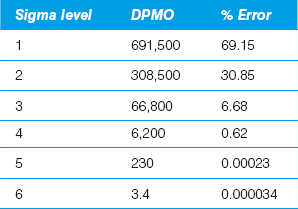Six Sigma level
Strategic perspective
Operational processes and supply chain perspective
Key performance question this indicator helps to answer
How capable are our processes of delivering error-free work?
Why is this indicator important?
The Six Sigma metric (which was pioneered by Motorola in the late 1980s and later adopted very successfully by global giants such as General Electric and Honeywell as well as many other companies of various sizes) informs managers as to the stability and predictability of process results. The goal is that process defect or error rates will be no more than 3.4 per one million opportunities. As an analogy, consider a goalkeeper of a football team who plays 50 games in a season and who faces 50 shots from the opposing team in each game. If a defect is when the team scores, then a Six Sigma goalkeeper would concede one goal every 147 years!
It is important to stress that Six Sigma is both a measure and a performance improvement methodology. As a methodology Six Sigma represents a set of tools that enable continuous or preferably breakthrough performance. These tools are based on the DMAIC principles:
- Define customer requirements (internal or external); that is, their expectation of the process.
- Measure the current performance; what is the frequency of defects?
- Analyse the data collected and map to determine cause and effect and opportunities for improvement; why, when and where do the defects occur?
- Improve the target process by designing solutions to improve, fix or prevent problems.
- Control the improvements to keep the process on the new course; how can we ensure that the process stays fixed?
DMAIC implementation is through an in-house team of Six Sigma certified employees, known as Master Black Belts, Black Belts or Green Belts depending on their experience and levels of involvement.
In essence, the promise is that by reaching Six Sigma performance levels, customer dissatisfaction will decrease significantly and that, ultimately, superior and sustainable financial results will be achieved.
How do I measure it?
Data collection method
Data are collected from three primary sources: input, process and output.
- The input source is where the process is generated.
- Process data refer to tests of efficiency: the time requirements, cost, value, defects or errors, and labour spent on the process.
- Output is a measurement of efficiency.
Formula
A Six Sigma defect is defined as anything outside of customer specifications, while a Six Sigma opportunity is the total quantity of chances for a defect.
First we calculate defects per million opportunities (DPMO) and based on that a Sigma is decided from a predefined table (see Example).
![]()
The number of defects is the total number of defects found, the number of units is the number of units produced and the number of opportunities means the number of ways to generate defects.
Frequency
The Sigma calculation is measured at the start of the project (baseline), at the end of the improvement project and then periodically to ensure the ‘control’ principle of DMAIC.
Source of the data
From available or generated process data.
Cost/effort in collecting the data
Costs and effort for collecting Six Sigma data can be high unless data collection is automated and data are readily available. Manual data collection and analysis are warranted only for key processes in an organisation. For other processes where data are automatically collected, such as in automated manufacturing, the costs are significantly lower.
Target setting/benchmarks
The Six Sigma measure of 3.4 is in itself a benchmark target, so companies would aim for 3.4 or less.
Example
Consider a food-ordering delivery project team that examined 50 deliveries and found the following:
Delivery is not on time (13).
Ordered food is not according to the order (3).
Food is not fresh (0).
So now DPMO will be as follows
![]()
According to the yield to Sigma conversion table (see below), 106,666.7 defects per million opportunities is equivalent to a Sigma level of between 2 and 3.
Table 38.1 Sample levels of Sigma performance according to the Sigma conversion table

Tips/warnings
A common criticism of Six Sigma is that the projects are typically implemented bottom-up. As a result, organisations spend a lot of effort on projects that look at tiny areas of their business. This way, they pick the lowest-hanging fruits but often miss the big opportunities. The biggest benefits from Six Sigma are secured when projects are related to the achievement of strategic goals. Six Sigma teams should focus on the most important strategically relevant projects and not just on those that deliver some financial gains.
Linked to the above, it is telling to note that although some of the organisations that became poster-boys for Six Sigma have indeed secured mouth-watering cost savings from their efforts, they have simultaneously been very poor performers on the stock market and have been recognised for their strategic failures. The argument has been that these organisations have been exclusively focused on using Six Sigma to identify cost-saving opportunities rather than as a tool to improve performance continuously against strategic goals: this is not how to get the best from Six Sigma projects.
References
Six Sigma Online: www.sixsigmaonline.org
Six Sigma.us: www.6sigma.us
Tutorials Point: www.tutorialspoint.com/six_sigma/six_sigma_measure_phase.htm
Pete Pande and Larry Holpp, What is Six Sigma? New York: McGraw-Hill, 2001.
Peter S. Pande, Robert P. Neuman and Roland R. Cavanagh, The Six Sigma Way: How GE, Motorola, and Other Top Companies are Honing Their Performance, New York: McGraw-Hill, 2000.
Bernard Marr, In defence of the nation and front-line troops, Raconteur on Lean and Six Sigma, The Times newspaper supplement, London, 8 June 2010.
